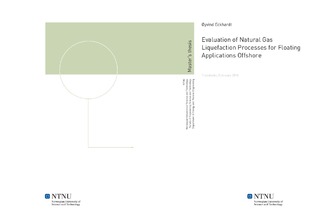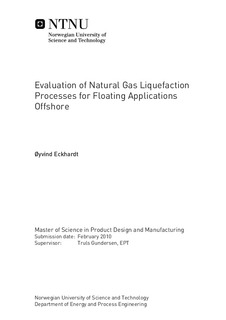| dc.description.abstract | A literature survey of LNG processes suitable for offshore environment has been evaluated. Thesurvey has been performed with emphasis on space requirements, complexity, efficiency and safety.Thermodynamics theory is described and used in the investigation of the NicheLNG process. Theliquefaction part of the HLNG FPSO-1 has been evaluated with respect to its energy consumption,improvements and the possibility to expand the process to give an indication about improvementpotentials. In addition, one alternative liquefaction process has been compared with the NicheLNGprocess.Dual expander processes based on nitrogen as refrigerant are the most proposed solution suitable foroffshore applications. Therefore it was chosen as an alternative process to NicheLNG. In theinvestigation of the two processes the processes simulated were with equal conditions. The NicheLNGprocess, based on an open methane cycle and a nitrogen cycle, had a significantly lower mass flow rateresulting in 10% lower power consumption. Decision of chosen refrigerant gas (methane or nitrogen)has different specific heat capacity and hence an influence on the flow rate. Methane as refrigerantrequires less mass flow rate than nitrogen for a given duty. In addition, higher pressure levels willcontribute to increased efficiency and reduced unit sizes.In the open refrigeration cycle of the NicheLNG process, methane is cooled down to -1,5°C before itis expanded. If the internal heat exchange is extended to -10°C before expansion is it possible toachieve some efficiency increase for the methane cycle.Comparison criteria are important when the quality of liquefaction processes is to be determined. Feedand product specifications provide some restrictions on obtainable efficiency. With an increasing feedgas pressure, the whole liquefaction process (from feed to LNG) demands less work, but the overallprocess efficiency is reduced due to the high efficiency of the feed gas compressor and the lowefficiency of the liquefaction part. Hence, the efficiency of the liquefaction process should not becalculated from its feed gas pressure but rather the liquefaction pressure. For the NicheLNG process,the exergy efficiency of the liquefaction part was calculated to 26,6%, with a liquefaction pressure at75 bar.An increase of LNG production with emphasis on improvements to keep work consumption down wasalso discussed. The four evaluated solutions were utilization of End Flash Gas, liquid expander,additional compressor and increase of heat exchanger area. The liquid expander was the improvementthat stands out as the highest contribution to the efficiency. With a 25% increase in LNG productionand with new units and modifications of the design resulted in a reduction in the specific workconsumption from 0,5502 kWh/kgLNG to 0,4791 kWh/kgLNG. These efficiency improvements canjustify higher investment costs since the work consumption, with 25% higher LNG production, was12,9% lower than for the original design of the NicheLNG process. Never the less, space and weighton a FPSO are limited and has to be considered when a more efficient process is desired. | nb_NO |

